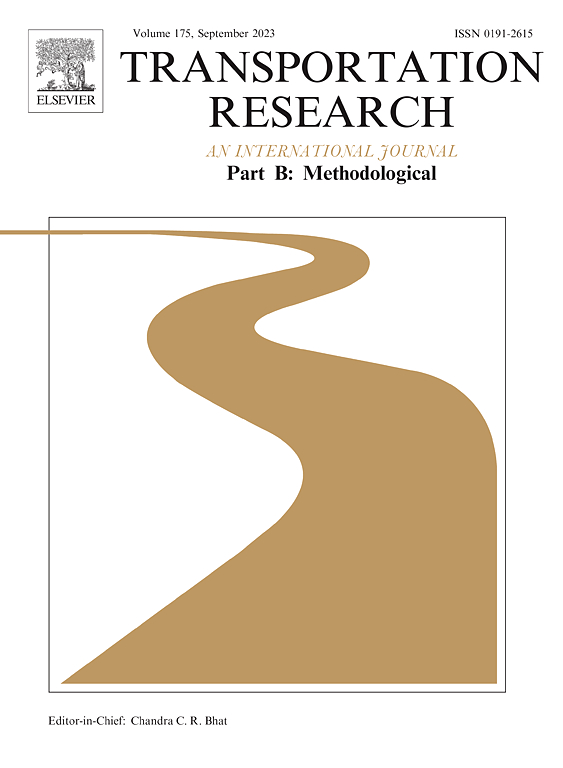What do walking and e-hailing bring to scale economies in on-demand mobility?
IF 5.8
1区 工程技术
Q1 ECONOMICS
引用次数: 0
Abstract
This study investigates the impact of walking and e-hailing on the scale economies of on-demand mobility services. An analytical framework is developed to i) explicitly characterize the physical interactions between passengers and vehicles in the matching and pickup processes, and ii) derive the closed-form degree of scale economies (DSE) to quantify scale economies. The general model is then specified for conventional street-hailing and e-hailing, with and without walking before pickup and after dropoff. We show that, under a system-optimum fleet size, the market always exhibits economies of scale regardless of the matching mechanism and the walking behaviors, though the scale effect diminishes as passenger demand increases. Yet, street-hailing and e-hailing show different scale economies in their matching process. While street-hailing matching shows a constant DSE of two, e-hailing matching is more sensitive to demand and its DSE diminishes to one when passenger competition emerges. Walking, on the other hand, has mixed effects on the scale economies: while the reduced pickup and in-vehicle times bring a positive scale effect, the extra walking time and possible concentration of vacant vehicles and waiting passengers on streets negatively affect scale economies. All these analytical results are validated through agent-based simulations on Manhattan with real-life demand patterns.
步行和网约车为按需出行的规模经济带来了什么?
本研究探讨了步行和网约车对按需出行服务规模经济的影响。开发了一个分析框架,以i)明确表征匹配和接送过程中乘客和车辆之间的物理相互作用,以及ii)导出封闭形式的规模经济程度(DSE)以量化规模经济。然后将一般模型指定为传统的街叫车和网叫车,在取车前和下车后有步行和没有步行。研究表明,在系统最优机队规模下,无论匹配机制和步行行为如何,市场都表现出规模经济,但规模效应随着乘客需求的增加而减弱。然而,网约车和网约车在匹配过程中表现出不同的规模经济。网约车匹配的DSE为2,而网约车匹配对需求更为敏感,当乘客竞争出现时,其DSE降至1。另一方面,步行对规模经济的影响是混合的:皮卡和车内时间的减少带来了积极的规模效应,而额外的步行时间和街道上空置车辆和等待乘客的可能集中对规模经济产生了负面影响。所有这些分析结果都通过基于智能体的模拟在曼哈顿与现实生活中的需求模式进行了验证。
本文章由计算机程序翻译,如有差异,请以英文原文为准。
求助全文
约1分钟内获得全文
求助全文
来源期刊
CiteScore
12.40
自引率
8.80%
发文量
143
审稿时长
14.1 weeks
期刊介绍:
Transportation Research: Part B publishes papers on all methodological aspects of the subject, particularly those that require mathematical analysis. The general theme of the journal is the development and solution of problems that are adequately motivated to deal with important aspects of the design and/or analysis of transportation systems. Areas covered include: traffic flow; design and analysis of transportation networks; control and scheduling; optimization; queuing theory; logistics; supply chains; development and application of statistical, econometric and mathematical models to address transportation problems; cost models; pricing and/or investment; traveler or shipper behavior; cost-benefit methodologies.

 求助内容:
求助内容: 应助结果提醒方式:
应助结果提醒方式:


